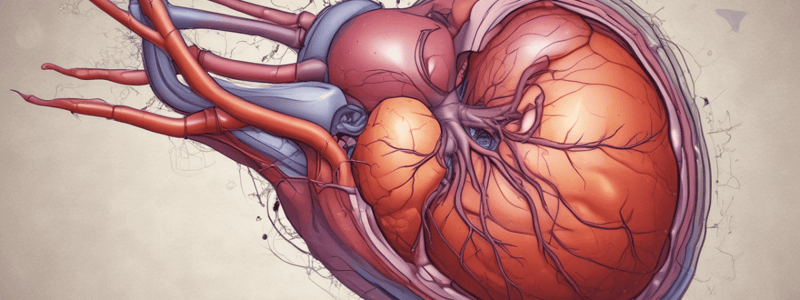Podcast
Questions and Answers
What is the most severe consequence of liver disease?
What is the most severe consequence of liver disease?
- Hepatorenal Syndrome
- Hepatic Failure (correct)
- Jaundice
- Hepatic Encephalopathy
What is the characteristic sign of Hepatic Encephalopathy that involves a rapid extension-flexion motion of the hand and extremities?
What is the characteristic sign of Hepatic Encephalopathy that involves a rapid extension-flexion motion of the hand and extremities?
asterixis
What is the by-product of protein metabolism and intestinal bacterial action implicated in causing many symptoms of hepatic encephalopathy?
What is the by-product of protein metabolism and intestinal bacterial action implicated in causing many symptoms of hepatic encephalopathy?
ammonia
Hepatitis A does not cause a carrier state or chronic hepatitis.
Hepatitis A does not cause a carrier state or chronic hepatitis.
Match the following hepatitis viruses with their respective characteristics:
Match the following hepatitis viruses with their respective characteristics:
What is the mechanism of liver injury involving induction of immune responses against the viral antigen with hepatitis virus?
What is the mechanism of liver injury involving induction of immune responses against the viral antigen with hepatitis virus?
What phase begins with the resolution of jaundice, about 8 weeks after exposure?
What phase begins with the resolution of jaundice, about 8 weeks after exposure?
What is chronic active hepatitis associated with?
What is chronic active hepatitis associated with?
Fulminant hepatitis can potentially lead to liver failure.
Fulminant hepatitis can potentially lead to liver failure.
Cirrhosis is a(n) _________ inflammatory disease that disrupts liver function and structure.
Cirrhosis is a(n) _________ inflammatory disease that disrupts liver function and structure.
Match the cause of cirrhosis with its description:
Match the cause of cirrhosis with its description:
Flashcards are hidden until you start studying
Study Notes
Liver Functions and Hepatic Failure
- The liver has a significant impact on health status and has numerous functions
- Hepatic failure is the most severe consequence of liver disease, with a high mortality rate (most patients die within weeks or months)
- Hepatic failure may occur suddenly due to fulminant hepatitis B or follow years of low-grade hepatitis C infection
- Approximately 90% of hepatic function must be destroyed before failure occurs
- Clinical features of hepatic failure include:
- Jaundice due to failure to excrete bilirubin
- Ascites due to increased portal pressure and blood osmotic pressure
- Fector hepatitis (liver breath) due to accumulation of volatile waste products such as ammonia
Hepatic Encephalopathy
- A complex neurologic syndrome characterized by memory lapses and personality changes
- Characteristic sign: asterixis (rapid extension-flexion motion of the hand and extremities)
- Results from accumulation of toxins in the blood when the liver fails to transform or detoxify the blood
- Toxins accumulate, leading to osmotic pressure increase, brain swelling, and cerebral edema, potentially causing herniation and death
- Ammonia is a key toxin implicated in causing many symptoms of hepatic encephalopathy
- Normally converted to urea by the liver, but in liver failure, ammonia reaches the brain, altering cerebral metabolism and interfering with neurotransmitters
Hepatorenal Syndrome
- A complication of advanced liver disease, characterized by renal failure associated with advanced liver disease
- Pathophysiology involves a sudden decrease in blood volume, leading to decreased GFR, tubular necrosis, and renal vasoconstriction
- Characteristics include:
- Blood volume expansion
- Hydrogen ion accumulation
- Electrolyte imbalance
Hepatitis
- Inflammation of the liver, caused by various factors, including viral infection, drug reactions, and infectious disorders
- Types of hepatitis include:
- Hepatitis A (formerly infectious hepatitis)
- Caused by small RNA-containing virus
- Transmitted through fecal-oral route, contaminated food, or water
- No carrier state or chronic hepatitis
- Hepatitis B (formerly serum hepatitis)
- Caused by double-stranded DNA virus
- Transmitted through contact with infected blood, body fluids, or contaminated needles
- Can produce acute hepatitis, chronic hepatitis, and fulminant hepatitis
- May lead to chronic liver disease and liver cancer
- Hepatitis C (formerly non-A, non-B hepatitis)
- Caused by single-stranded RNA virus
- Most cases of post-transfusion hepatitis, and most common blood-borne infection in the US
- Chronic hepatitis occurs in 50-80% of cases, and may lead to cirrhosis and liver cancer
- Hepatitis D (delta)
- A defective RNA virus that co-infects with HBV
- Increases severity of HBV infection
- Hepatitis E
- Common in developing countries
- Clinically resembles Hepatitis A
- Does not cause chronic or carrier state
- Hepatitis G
- Not much known, possibly related to post-transfusion hepatitis
- Hepatitis A (formerly infectious hepatitis)
Liver Injury and Cirrhosis
- Liver injury mechanisms include:
- Direct cellular injury
- Induction of immune responses against viral antigens
- Pathophysiology of hepatitis includes:
- Hepatic cell necrosis
- Scarring leading to fibrosis
- Kupffer cell hyperplasia and infiltration with phagocytic cells
- Cell injury promoted by cell-mediated immunity
- Cirrhosis:
- An irreversible inflammatory disease disrupting liver function and structure
- Leading cause of death in the US
- Represents the end stage of chronic liver disease
- Characteristics include:
- Disrupted liver architecture and function
- Nodular regeneration and fibrosis
- Portal hypertension and ascites
- Liver hard, firm, and cobbly when palpated
- Causes of cirrhosis include:
- Alcoholic cirrhosis (Laennec's cirrhosis)
- Biliary cirrhosis (primary and secondary)
- Post-necrotic cirrhosis
Studying That Suits You
Use AI to generate personalized quizzes and flashcards to suit your learning preferences.




